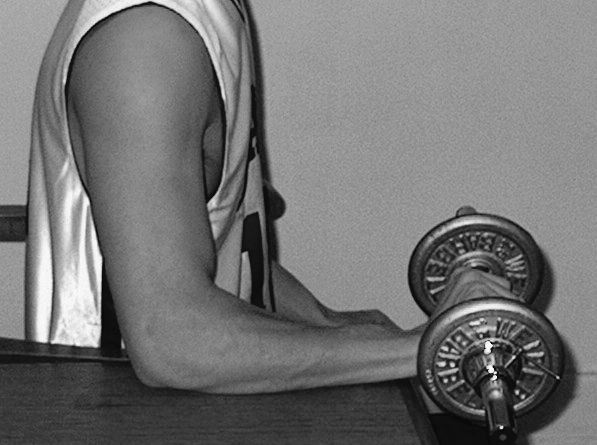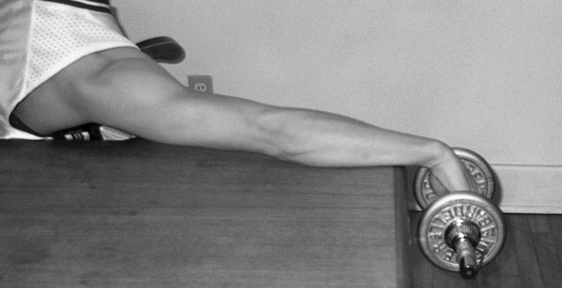Lateral epicondylitis, commonly referred to as tennis elbow, affects 1% to 3% of the population.1 It is thought to be an overuse injury, originating in the wrist extensor muscles, rather than an inflammatory problem. It is brought on by occupational activities and sports that involve a repetitive wrist motion or a power grip. The condition is most commonly associated with work-related activities,2 such as cutting meat, plumbing, and working on cars, rather than with playing tennis.
The overuse causes microtears near the origin of the extensor carpi radialis brevis (ECRB) at the lateral epicondyle. This leads to the formation of fibrosis and granulation tissue. Infiltration of inflammatory cells takes place early on3 but is probably absent in more chronic cases.
There are various treatment options available, including local steroid injections, strapping, extracorporeal shock wave therapy, and acupuncture; however, many cases are difficult to treat successfully.4 Although exercise treatments are often recommended, the descriptions of these exercises lack sufficient detail.
The following article describes a muscle-strengthening program that involves progressive eccentric and concentric resistance exercises for treatment of lateral epicondylitis. The exercises can be done at home, and require only dumbbells, an instruction sheet, and the will to get better. Several of our patients who participated in this program have experienced long-term pain relief.
Muscle-strengthening program
The muscle-strengthening program was initially proposed by Dr Ernest W. Johnson (oral communication, October 2003), an American physiatrist from Ohio State University in Columbus. The program, described in Table 1, encompasses a 10-repetition maximum of eccentric and concentric movements of the wrist extensor muscles in 2 different positions: first with the elbow flexed to 90° (Figure 1), then with the elbow extended to 180° (Figure 2). The forearm is pronated in both positions. Slow full-wrist extensions are followed by slow full-wrist flexions; each full-wrist extension and full-wrist flexion should take 5 to 10 seconds. A “10-repetition maximum” means that it is difficult (or impossible) to do more than 10 repetitions with the given weight (handheld dumbbell). It is normal for pain to be present while performing the exercises. The weight is progressively increased when 10 repetitions can be completed without pain.
Table 1. Muscle-strengthening program to treat lateral epicondylitis.
Patient instructions.*
|
Remember that it will hurt to do the exercises. “Good pain” occurs when it hurts while doing the exercise but the next day the pain is not worse. “Bad pain” is pain that increases the day after the treatment. If you experience “bad pain,” you might have to cut back on the number of repetitions or the amount of weight used.
Modified with permission from Dr Ernest W. Johnson (Ohio State University in Columbus).
Figure 1.

Flexion of the elbow to 90° (concentric contraction of wrist extensor muscles)
Figure 2.
Extension of the elbow to 180° (eccentric contraction of wrist extensor muscles)
Typically, the pain of lateral epicondylitis decreases after 4 to 6 weeks of diligently performing the exercises once a day, 7 days a week.
Discussion
The rationale for the protocol of this regimen is that stressing the attachment of the ECRB through progressive eccentric and concentric resistance exercises results in the production of a dense collagenous scar in the area of attachment; thus, pain is eliminated. This idea is supported by the work of Curwin and Stanish,5 who wrote that the tension created through eccentric contractions allows the formation of new fibrous tissue at the musculotendinous unit, making it more resistant to damage. Other possible explanations for the positive effects of eccentric training on tendonitis include “lengthening” of the muscle-tendon unit, which might result in less strain during elbow joint motion, or “loading” of the muscle-tendon unit, which might increase the tensile strength of the tendon and cause hypertrophy of the muscle belly.
Both eccentric and concentric contractions increase muscle strength, but the former improve muscle strength more than the latter.6 Curwin and Stanish5 postulated that only eccentric contractions sufficiently generate the tension necessary for forming fibrous tissue at the musculotendinous structure, allowing adaptation to increased tension. These powerful contractions often result in soreness and potential damage to the muscle itself.7 On the basis of these findings, Walmsley et al8 stated that the addition of concentric contractions decreases muscle tension during the training regimen, thus minimizing muscle soreness and damage.
In our program, the exercises are done with the elbow in 2 positions. The 90° flexed position likely isolates the ECRB as the extensor carpi radialis longus attaches above the lateral epicondyle (lateral supracondylar ridge of the distal humerus). The 180° extended position is important because the extensor muscles, including the ECRB, are stretched further, creating more stress on the tendon during the exercises. The increase in tension generated from this extra stretch helps to build the collagenous scar in the area of attachment. This is the only program we know of that adopts both positions.
Croisier et al9 also showed benefits with a combined eccentric and concentric treatment; however, their program required the use of a specialized device that is not freely available in people’s homes.
Conclusion
The eccentric and concentric treatment regimen that we describe is inexpensive, convenient, and, in our experience, effective. Patients must be compliant and have some tolerance for pain. They need to be counseled about the exacerbation of pain when performing the exercises. Patients should also be provided with a detailed instruction sheet to enable them to safely follow the protocol at home.
Acknowledgment
We are grateful to Dr Sue Dojeiji and Dr Scott Wiebe for their helpful review of the manuscript. We thank Dr Arie Peliowski and Gloria Baker for editing the manuscript.
Footnotes
Competing interests
None declared
Cet article a fait l’objet d’une révision par des pairs.
We encourage readers to share some of their practice experience: the neat little tricks that solve difficult clinical situations. Practice Tips can be submitted on-line at http://mc.manuscriptcentral.com/cfp or through the CFP website www.cfp.ca under “Authors.”
This article has been peer reviewed.
References
- 1.Allander E. Prevalence, incidence, and remission rates of some common rheumatic diseases and syndromes. Scand J Rheumatol. 1974;3(3):145–53. doi: 10.3109/03009747409097141. [DOI] [PubMed] [Google Scholar]
- 2.Thorson EP. Tendonitis of the wrist and elbow. Occup Med. 1989;4(3):419–34. [PubMed] [Google Scholar]
- 3.Goldie I. Epicondylitis lateralis humeri (epicondylalgia or tennis elbow): a pathologenetical study. Acta Chir Scand Suppl. 1964;57(Suppl 339):104–9. [PubMed] [Google Scholar]
- 4.Pienimäki T. Progressive strengthening and stretching exercises and ultrasound for chronic lateral epicondylitis. Physiotherapy. 1996;82:522–30. [Google Scholar]
- 5.Curwin S. Tendinitis: its etiology and treatment. Toronto, ON: Collamore Press, DC Heath and Company; 1984. [Google Scholar]
- 6.Komi PV. Effect of eccentric and concentric muscle conditioning on tension and electrical activity in human muscle. Ergonomics. 1972;15(4):417–34. doi: 10.1080/00140137208924444. [DOI] [PubMed] [Google Scholar]
- 7.Abrahams WH. Exercise-induced muscle soreness. Phys Sports Med. 1980;12:94. [Google Scholar]
- 8.Walmsley RP. Eccentric wrist extensor contractions and the force velocity relationship in muscle. J Orthop Sports Phys Ther. 1986;8:288–93. doi: 10.2519/jospt.1986.8.6.288. [DOI] [PubMed] [Google Scholar]
- 9.Croisier JL. An iso-kinetic eccentric program for the management of chronic lateral epicondylar tendinopathy. Br J Sports Med. 2007;41(4):269–75. doi: 10.1136/bjsm.2006.033324. Epub 2007 Jan 15. [DOI] [PMC free article] [PubMed] [Google Scholar]



